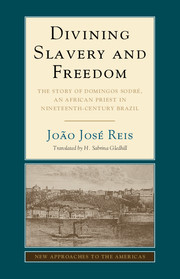 Divining Slavery and Freedom
Divining Slavery and Freedom Book contents
- Frontmatter
- Dedication
- Contents
- Preface
- Abbreviations
- Map
- 1 Cops and Candomblé in Domingos Sodré's Day
- 2 From an African in Onim to a Slave in Bahia
- 3 Domingos Sodré, Diviner
- 4 Witchcraft and Slavery
- 5 Witchcraft and Manumission
- 6 Meet Some Friends of Domingos Sodré
- 7 Domingos Sodré, Ladino Man of Means
- Epilogue
- Timeline of Domingos Sodré's Life
- Glossary
- Appendix 1 Domingos Sodré's Last Will and Testament (1882)
- Appendix 2 Domingos' Manumission and Manumissions Granted by Him
- Appendix 3 Delfina's Petition Guaranteeing Her Mental Health
- Illustration and Map Credits
- Bibliography
- Acknowledgments
- Name Index
- Subject Index
5 - Witchcraft and Manumission
Published online by Cambridge University Press: 05 May 2015
- Frontmatter
- Dedication
- Contents
- Preface
- Abbreviations
- Map
- 1 Cops and Candomblé in Domingos Sodré's Day
- 2 From an African in Onim to a Slave in Bahia
- 3 Domingos Sodré, Diviner
- 4 Witchcraft and Slavery
- 5 Witchcraft and Manumission
- 6 Meet Some Friends of Domingos Sodré
- 7 Domingos Sodré, Ladino Man of Means
- Epilogue
- Timeline of Domingos Sodré's Life
- Glossary
- Appendix 1 Domingos Sodré's Last Will and Testament (1882)
- Appendix 2 Domingos' Manumission and Manumissions Granted by Him
- Appendix 3 Delfina's Petition Guaranteeing Her Mental Health
- Illustration and Map Credits
- Bibliography
- Acknowledgments
- Name Index
- Subject Index
Summary
At the time of his arrest, Domingos Sodré was involved in a lawsuit against Elias Francisco de Seixas, an African freedman. Elias had been accused of murdering another African freedman and appropriating the money from a manumission society headed by Domingos. About seventy-four years old in 1862, Elias fathered four children born in Brazil, had a farm in the outskirts of Salvador, and owned several slaves. He lived in Mata Escura, within the boundaries of the second district of Santo Antônio parish, whose subdelegado was João de Azevedo Piapitinga, a name that is already familiar to us. Now we will get to know Elias better, as he was another significant figure in Domingos' life. Their dispute sheds light on several aspects of African life in Bahia, which included both solidarity and conflict within the group, the formation of clienteles around powerful characters, the use by Africans of the local justice system in conjunction with their own, and once again, it is another angle for observing the passage from slavery to freedom and Domingo's role in that process.
ELIAS FRANCISCO SEIXAS
Elias was the former slave of Maria Dorothea da Silveira Seixas. According to the terms of her will and testament, she had freed him upon her death on February 21, 1838, in Itapoã, a fishing village several miles north of Salvador, where she had taken refuge from a city besieged by the legal forces that crushed the Sabinada, a liberal revolt against the central government based in Rio de Janeiro, in a bloodbath. That lady had been widowed twice from her marriages to Captain Álvaro Sanches de Brito and Comendador (an honorary imperial title) José Venâncio de Seixas. Like Domingos, the freedman had been the slave of powerful masters. Elias took his surname from his last mistress, sometimes adding his deceased master's middle name, Venâncio, as he did in at least three notarized documents.
- Type
- Chapter
- Information
- Divining Slavery and FreedomThe Story of Domingos Sodré, an African Priest in Nineteenth-Century Brazil, pp. 173 - 209Publisher: Cambridge University PressPrint publication year: 2015
